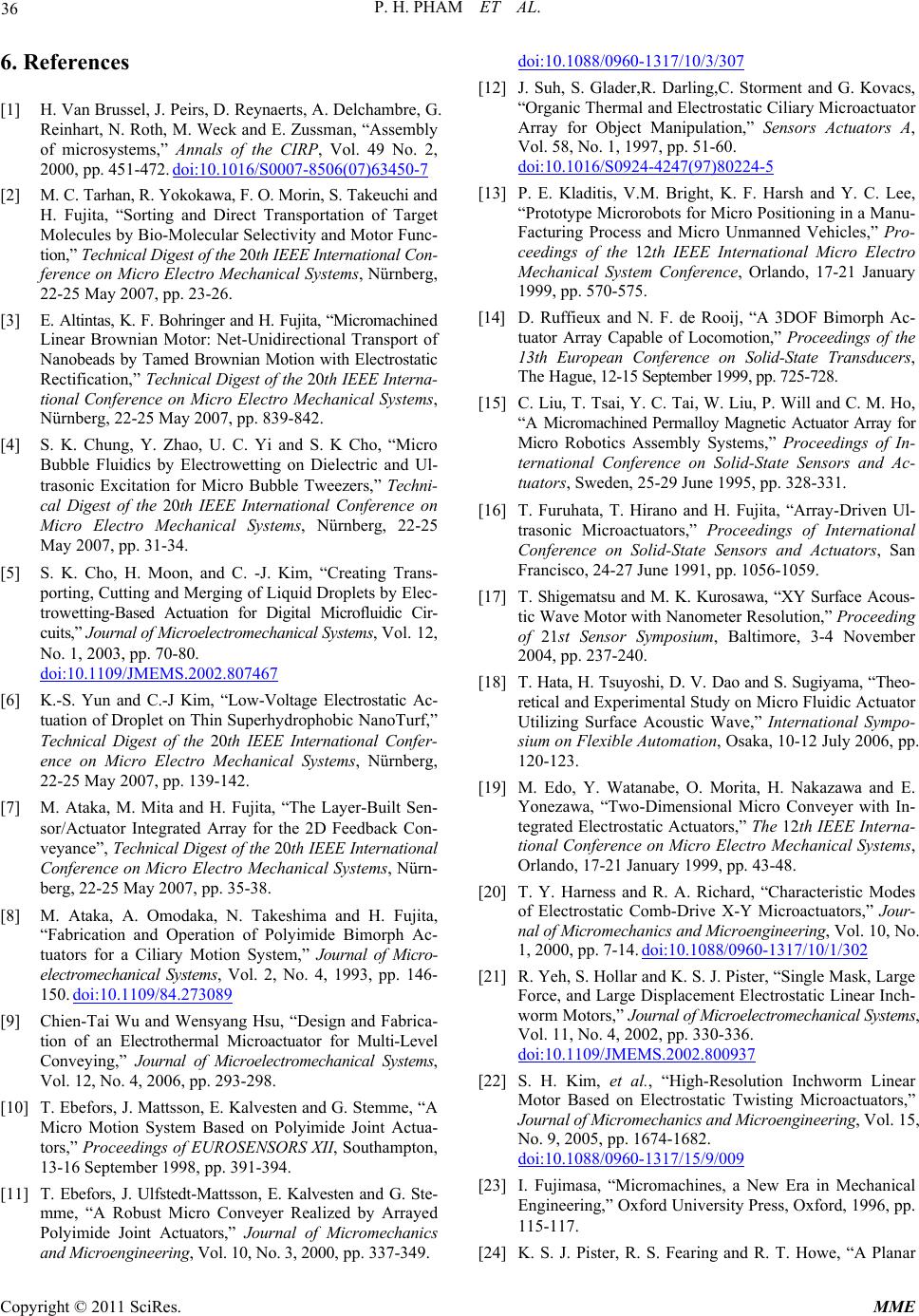
P. H. PHAM ET AL.
36
6. References
[1] H. Van Brussel, J. Peirs, D. Reynaerts, A. Delchambre, G.
Reinhart, N. Roth, M. Wec k and E. Zussman, “Assembly
of microsystems,” Annals of the CIRP, Vol. 49 No. 2,
2000, pp. 451-472. doi:10.1016/S0007-8506(07)63450-7
[2] M. C. Tarhan, R. Yokoka wa, F. O. Mori n, S. Take uchi and
H. Fujita, “Sorting and Direct Transportation of Target
Molecules by Bio-Molecular Selectivity and Motor Func-
tion,” Technical Digest of the 20th IEEE International Con-
ference on Micro Electro Mechanical Systems, Nürnberg,
22-25 May 2007, pp. 23-26.
[3] E. Altinta s, K. F. Bohringer and H. Fujita, “Micromachine d
Linear Brownian Motor: Net-Unidirectional Transport of
Nan obeads by Tamed Brownian Motion with Electrostatic
Rectification,” Technical Digest of the 20th IEEE Interna-
tional Conference on Micro Electro Mechanical Systems,
Nürnberg, 22-25 May 2007, pp. 839-842.
[4] S. K. Chung, Y. Zhao, U. C. Yi and S. K Cho, “Micro
Bubble Fluidics by Electrowetting on Dielectric and Ul-
trasonic Excitation for Micro Bubble Tweezers,” Techni-
cal Digest of the 20th IEEE International Conference on
Micro Electro Mechanical Systems, Nürnberg, 22-25
May 2007, pp. 31-34.
[5] S. K. Cho, H. Moon, and C. -J. Kim, “Creating Trans-
porting, Cutting and Merging of Liquid Droplets by Elec-
trowetting-Based Actuation for Digital Microfluidic Cir-
cuits,” Journal of Microelectromechanical Systems, Vol . 1 2 ,
No. 1, 2003, pp. 70-80.
doi:10.1109/JMEMS.2002.807467
[6] K.-S. Yun and C.-J Kim, “Low-Voltage Electrostatic Ac-
tuation of Droplet on Thin Superhydrophobic NanoTurf,”
Technical Digest of the 20th IEEE International Confer-
ence on Micro Electro Mechanical Systems, Nürnberg,
22-25 May 2007, pp. 139-142.
[7] M. Ataka, M. Mita and H. Fujita, “The Layer-Built Sen-
sor/Actuator Integrated Array for the 2D Feedback Con-
veyance”, Technical Digest of the 20th IEEE International
Conference on Micro Electro Mechanical Systems, Nürn-
berg, 22-25 May 2007, pp. 35-38.
[8] M. Ataka, A. Omodaka, N. Takeshima and H. Fujita,
“Fabrication and Operation of Polyimide Bimorph Ac-
tuators for a Ciliary Motion System,” Journal of Micro-
electromechanical Systems, Vol. 2, No. 4, 1993, pp. 146-
150. doi:10.1109/84.273089
[9] Chien-Tai Wu and Wensyang Hsu, “Design and Fabrica-
tion of an Electrothermal Microactuator for Multi-Level
Conveying,” Journal of Microelectromechanical Systems,
Vol. 12, No. 4, 2006, pp. 293-298.
[10] T. Ebefors, J. Mattsson, E. Kalvesten and G. Stemme, “A
Micro Motion System Based on Polyimide Joint Actua-
tors,” Proceedings of EUROSENSORS XII, Southampton,
13-16 September 1998, pp. 391-394.
[11] T. Ebefors, J. Ulfstedt-Mattsson, E. Kalvesten and G. Ste-
mme, “A Robust Micro Conveyer Realized by Arrayed
Polyimide Joint Actuators,” Journal of Micromechanics
and Microengineering, Vol. 10, No. 3, 2000, pp. 337-349.
doi:10.1088/0960-1317/10/3/307
[12] J. Suh, S. Glader,R. Darling,C. Storment and G. Kovacs,
“Organic Thermal and Electrostatic Ciliary Microactuator
Array for Object Manipulation,” Sensors Actuators A,
Vol. 58, No. 1, 1997, pp. 51-60.
doi:10.1016/S0924-4247(97)80224-5
[13] P. E. Kladitis, V.M. Bright, K. F. Harsh and Y. C. Lee,
“Prototype Microrobots for Micro Positioning in a Manu-
Facturing Process and Micro Unmanned Vehicles,” Pro-
ceedings of the 12th IEEE International Micro Electro
Mechanical System Conference, Orlando, 17-21 January
1999, pp. 570-575.
[14] D. Ruffieux and N. F. de Rooij, “A 3DOF Bimorph Ac-
tuator Array Capable of Locomotion,” Proceedings of the
13th European Conference on Solid-State Transducers,
The Hague, 12-15 September 1999, p p. 725 -728.
[15] C. Liu, T. Tsai, Y. C. Tai, W. Liu, P. Will and C. M. Ho,
“A Micromachined Permalloy Magnetic Actuator Array for
Micro Robotics Assembly Systems,” Proceedings of In-
ternational Conference on Solid-State Sensors and Ac-
tuators, Sweden, 25-29 June 1995, pp. 328-331.
[16] T. Furuhata, T. Hirano and H. Fujita, “Array-Driven Ul-
trasonic Microactuators,” Proceedings of International
Conference on Solid-State Sensors and Actuators, San
Francisco, 24-27 June 1991, pp. 1056-1059.
[17] T. Shigematsu and M. K. Kurosawa, “XY Surface Acous-
tic Wave Motor with Nanometer Resolution,” Proceeding
of 21st Sensor Symposium, Baltimore, 3-4 November
2004, pp. 237-240.
[18] T. Hata, H. Tsuyoshi, D. V. Dao and S. Sugiyama, “Theo-
retical and Experimental Study on Micro Fluid ic Actua tor
Utilizing Surface Acoustic Wave,” International Sympo-
sium on Flexible Automation, Osaka, 10-12 July 2006, pp.
120-123.
[19] M. Edo, Y. Watanabe, O. Morita, H. Nakazawa and E.
Yonezawa, “Two-Dimensional Micro Conveyer with In-
tegrated Electrostatic Actuators,” The 12th IEEE Interna-
tional Conference on Micro Electro Mechanical Systems,
Orlando, 17-21 January 1999, pp. 43-48.
[20] T. Y. Harness and R. A. Richard, “Characteristic Modes
of Electrostatic Comb-Drive X-Y Microactuators,” Jour-
nal of Micromechanics and Microengineering, V ol . 1 0 , No .
1, 2000, pp. 7-14. doi:10.1088/0960-1317/10/1/302
[21] R. Yeh, S. Hollar and K. S. J. Pister, “Single Mask, Large
Force, and Large Displacement Electrostatic Linear Inch-
worm Motors,” Journal of Microelectromechanical Systems,
Vol. 11, No. 4, 2002, pp. 330-336.
doi:10.1109/JMEMS.2002.800937
[22] S. H. Kim, et al., “High-Resolution Inchworm Linear
Motor Based on Electrostatic Twisting Microactuators,”
Journal of Micromechanics and Microengineering, Vol. 15,
No. 9, 2005, pp. 1674-1682.
doi:10.1088/0960-1317/15/9/009
[23] I. Fujimasa, “Micromachines, a New Era in Mechanical
Engineering,” Oxford University Press, Oxford, 1996, pp.
115-117.
[24] K. S. J. Pister, R. S. Fearing and R. T. Howe, “A Planar
Copyright © 2011 SciRes. MME